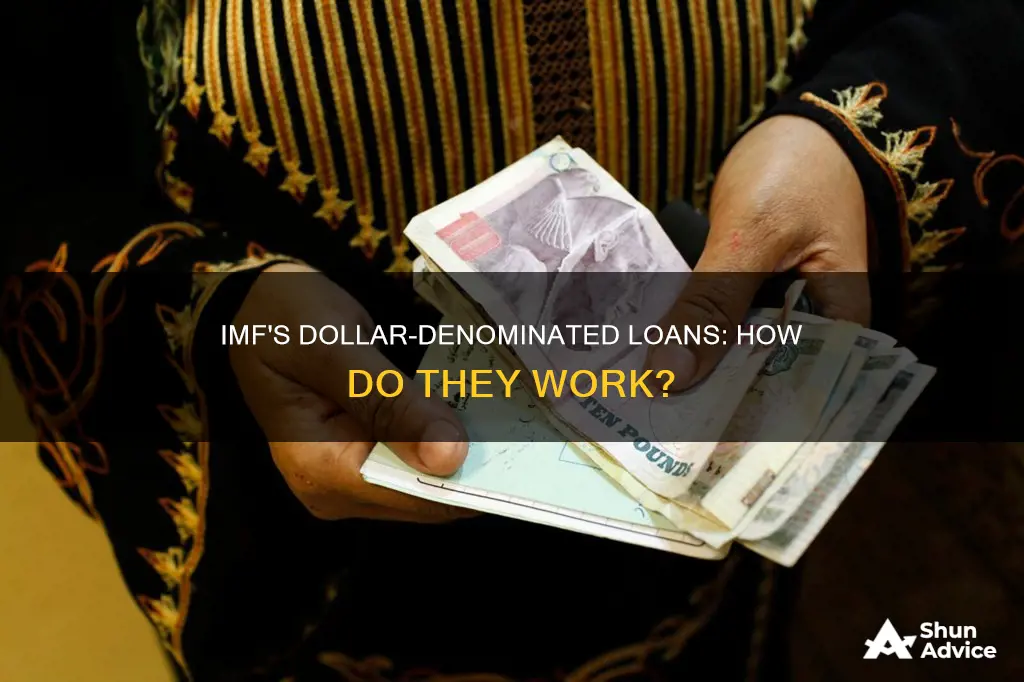
The International Monetary Fund (IMF) lends money to member countries facing economic crises or to prevent crises from occurring. The IMF offers various types of loans tailored to countries' different needs and circumstances. The IMF's current total resources of about SDR 982 billion translate into a capacity for lending of about SDR 695 billion (around US$932 billion), as of mid-December 2023. The IMF lends in Special Drawing Rights (SDRs), an international reserve asset created by the IMF in 1969 to supplement its member countries' official reserves.
Does IMF Issue Loans in Dollars?
| Characteristics | Values |
|---|---|
| IMF Loans in Dollars | Yes |
| IMF Loan Types | Various, including Stand-by Arrangement (SBA), Extended Fund Facility (EFF), Flexible Credit Line (FCL), Precautionary and Liquidity Line (PLL), Short-term Liquidity Line (SLL), and Rapid Financing Instrument (RFI) |
| IMF Loan Recipients | Member countries, not the private sector or civil society |
| IMF Loan Purpose | Financial support to countries facing economic crises or to prevent crises from occurring |
| IMF Loan Conditions | Policy changes implemented by recipient governments |
| IMF Loan Interest Rates | Vary depending on the loan type and recipient country's circumstances; loans to low-income countries carry a zero interest rate |
| IMF Loan Repayment | In installments, linked to demonstrable policy actions by the recipient country |
| IMF Loan Surcharges and Fees | Include time-based surcharges, commitment fees, and service charges |
| IMF Funding Sources | Member quotas, multilateral and bilateral borrowing agreements, and New Arrangements to Borrow (NAB) |
| IMF Lending Capacity | As of mid-December 2023, the IMF's lending capacity is approximately SDR 695 billion (around US$932 billion) |
What You'll Learn
- IMF loans are tailored to meet countries' different needs and circumstances
- IMF lending gives countries room to adjust policies and restore economic stability
- IMF funds come from member quotas, multilateral and bilateral borrowing agreements
- IMF loans come with conditions, such as policy changes, to safeguard resources
- IMF loans are paid in instalments and linked to demonstrable policy actions

IMF loans are tailored to meet countries' different needs and circumstances
The IMF offers a variety of loans that are tailored to meet the diverse needs and circumstances of its member countries. The IMF's financial support is designed to provide countries with the necessary flexibility to adjust their policies and work towards achieving a stable economy and sustainable growth.
For instance, a country grappling with a sudden decline in the price of its key exports may require financial assistance to bolster its economy and diversify its exports. In such a case, the IMF can step in with a loan that carries a zero interest rate, as was done for several countries following the Global Financial Crisis. This assistance can help the country navigate the crisis and set the stage for economic recovery.
The IMF's lending programs are not limited to specific projects but instead focus on addressing crises and their underlying causes. These crises can be multifaceted, stemming from factors such as fiscal and monetary policy missteps, exchange rate issues, or weaknesses in the financial system. Political instability and weak institutions can also play a role. By providing financial support, the IMF gives countries the breathing room they need to implement corrective policies and restore economic stability.
The IMF's loans are also designed to protect and enhance social spending, particularly in the health sector, for low-income countries. Additionally, the IMF acts as a catalyst for private-sector investments and attracts financial support from international financial institutions, signalling that the country is on the path to resolving its underlying issues.
The IMF's lending instruments are flexible and adaptable, taking into account each country's unique circumstances. For instance, the Resilience and Sustainability Trust offers longer-term financing to low- and middle-income countries, helping them build resilience against external shocks with affordable interest rates. The IMF's commitment fees and surcharges are also structured to be refunded proportionally as the borrowing member repays the loan.
Hospice Equipment: What's Available on Loan?
You may want to see also

IMF lending gives countries room to adjust policies and restore economic stability
The International Monetary Fund (IMF) lends to its members on non-concessional terms, with funds coming from member countries, mainly through their payment of quotas. The IMF does not lend money for specific projects. Instead, it provides financial support to countries facing crises, giving them the breathing room to implement policies that restore economic stability and growth.
The IMF's lending gives countries room to adjust their policies and restore economic stability. When a country borrows from the IMF, its government agrees to adjust its economic policies to address the problems that led it to seek financial assistance in the first place. These policy adjustments are conditions for IMF loans and are designed to ensure the adoption of strong and effective policies. The overarching goal is to restore or maintain balance of payments viability and macroeconomic stability, setting the stage for sustained, high-quality growth.
The IMF's lending conditions vary depending on the country's circumstances. For example, a country facing a sudden drop in the price of key exports may need financial assistance while working to strengthen its economy and diversify its exports. On the other hand, a country experiencing severe capital outflows may need to restore investor confidence by addressing issues like low-interest rates, rapid budget deficit growth, or an inefficient banking system. Without timely IMF financing, a country's adjustment process may be more challenging, potentially resulting in a compression of government spending, imports, and economic activity.
The IMF also provides concessional financial support through the Poverty Reduction and Growth Trust, offering zero-interest loans to low-income countries. This support is tailored to meet the diverse needs of these countries, with an additional objective of reducing poverty. The Resilience and Sustainability Trust provides longer-term financing to vulnerable low and middle-income countries seeking to build resilience against external shocks.
The IMF's lending programs have evolved over time, becoming more flexible and adaptable to meet countries' changing needs. The IMF responds to global challenges, such as the recent food crisis, by introducing measures like the Food Shock Window to address urgent balance-of-payment needs related to food insecurity. The IMF's efforts promote stability and growth, helping vulnerable countries adjust their policies and fostering their economic recovery.
Understanding Your Rights to Your Spouse's 401(k) Loan
You may want to see also

IMF funds come from member quotas, multilateral and bilateral borrowing agreements
The International Monetary Fund (IMF) provides financial support to countries facing crises, helping them to implement policies that restore economic stability and growth. The IMF does not lend money for specific projects, but instead offers countries breathing room to adjust their policies in an orderly manner, with the aim of achieving sustainable growth.
The IMF's funds come from three sources: member quotas, multilateral borrowing agreements, and bilateral borrowing agreements. Quotas are the primary source of IMF funding, with each member country assigned a quota based on its relative position in the world economy. These quotas are regularly reviewed by the IMF to assess their overall adequacy and distribution among members. As of mid-December 2023, the IMF's total resources were about SDR 982 billion, translating to a lending capacity of around SDR 695 billion (approximately US$932 billion).
Supplementing the quota funds are multilateral and bilateral borrowing agreements, which play a critical role in supporting member countries during times of crisis. The New Arrangements to Borrow (NAB) constitute a second line of defense, where member countries and institutions are ready to lend additional resources to address challenges to the international monetary system. The size of the NAB was doubled in 2021, contributing SDR 364 billion (US$485 billion) to the IMF's total resources.
Bilateral Borrowing Agreements (BBAs) serve as a third line of defense. The IMF has entered into several rounds of BBAs to meet its members' financing needs, especially during the global financial crisis. The 2020 BBAs included 42 creditors, totaling SDR 141 billion (US$188-189 billion) in commitments. These agreements are typically extendable with creditor consent.
Homestyle Loan: Landscaping Covered?
You may want to see also

IMF loans come with conditions, such as policy changes, to safeguard resources
The International Monetary Fund (IMF) offers various types of loans tailored to countries' different needs and circumstances. The IMF lends to countries facing crises, providing financial support to help them implement policies that restore economic stability and growth.
When a country borrows from the IMF, its government agrees to adjust its economic policies to address the issues that led it to seek financial assistance in the first place. These policy adjustments are conditions for obtaining IMF loans and are intended to ensure that the borrowing country adopts robust and effective policies. The conditions are designed to help countries resolve their balance of payments problems without resorting to measures detrimental to national or international prosperity.
The IMF's conditions for lending typically involve policy changes. Until the early 1980s, the IMF's focus was primarily on macroeconomic policies. However, as the IMF became more involved with low-income and transitional countries, the conditions became more complex and wide-ranging. These conditions may include addressing issues such as inappropriate fiscal and monetary policies, an exchange rate fixed at an inappropriate level, or a weak financial system.
The IMF safeguards its resources through various measures, including safeguards assessments of central banks. These assessments were introduced in 2000 to address misreporting and allegations of resource misuse. They are now an integral part of the IMF's lending process, typically reviewed every five years. The assessments cover six key areas, known as GELRIC:
- Governance: The assessment evaluates the governance structures and systems of the central bank, including the autonomy and transparency of its legal framework.
- Legal framework: This area examines the adequacy of the legal framework supporting the central bank's operations and its alignment with international good practices for transparency.
- Autonomy: The assessment considers the central bank's independence from government interference and its ability to make decisions without undue influence.
- Reporting: The IMF reviews the timeliness and accuracy of the central bank's financial reporting, ensuring consistency between monetary data and published financial information.
- Internal audit: The internal audit function of the central bank is assessed for its compliance with international standards and capacity to evaluate the bank's risk management and governance processes.
- International reserves: The IMF also considers the central bank's international reserves, ensuring they are sufficient to support the country's economic programs.
By imposing conditions and conducting safeguards assessments, the IMF aims to ensure that its loans are repaid timely, safeguarding its resources for lending to other countries facing economic challenges.
Illinois and the US Rule Loan: What You Need to Know
You may want to see also

IMF loans are paid in instalments and linked to demonstrable policy actions
The IMF offers various types of loans that are tailored to countries' different needs and circumstances. IMF lending gives countries the flexibility to adjust their policies in an orderly manner, paving the way for a stable economy and sustainable growth. Countries that borrow from the IMF have the primary responsibility for selecting, designing, and implementing policies to make their economic programs successful. IMF loans are not provided for specific projects but to help countries implement policies that restore economic stability and growth.
Policy commitments can take various forms, including prior actions, which are steps a country agrees to take before the IMF approves financing or completes a review. These prior actions ensure that the program has the necessary foundation for success. Specific, measurable conditions for IMF lending are always related to macroeconomic variables under the control of the borrowing country's authorities, such as monetary and credit aggregates, international reserves, fiscal balances, and external borrowing.
The IMF also imposes commitment fees, which are typically a small percentage of the loan amount. These fees are levied at the beginning of each 12-month period on amounts that could be drawn during that period. Commitment fees are refunded to the borrowing member proportionally to the drawings made, and additional fees or refunds may apply under certain circumstances. Furthermore, a service charge is applied to each amount drawn from the GRA, currently at 50 basis points, except for the Short-term Liquidity Line (SLL), which has a reduced rate of 21 basis points.
HUD Construction Loans: What You Need to Know
You may want to see also
Frequently asked questions
The International Monetary Fund (IMF) lends money to member countries to help them through economic crises or to prevent crises from occurring.
Yes, the IMF issues loans in Special Drawing Rights (SDRs) and US dollars. As of mid-December 2023, the IMF's lending capacity was about SDR 695 billion (around US$932 billion).
The IMF offers various types of loans that are tailored to countries' different needs and specific circumstances. Loans to low-income countries carry a zero-interest rate. The IMF also provides precautionary financing to help prevent crises.
IMF loans come with conditions attached related to policy changes that governments are required to make to receive funding. These conditions are designed to ensure countries adopt strong and effective policies to overcome the problems that led them to seek financial assistance.







